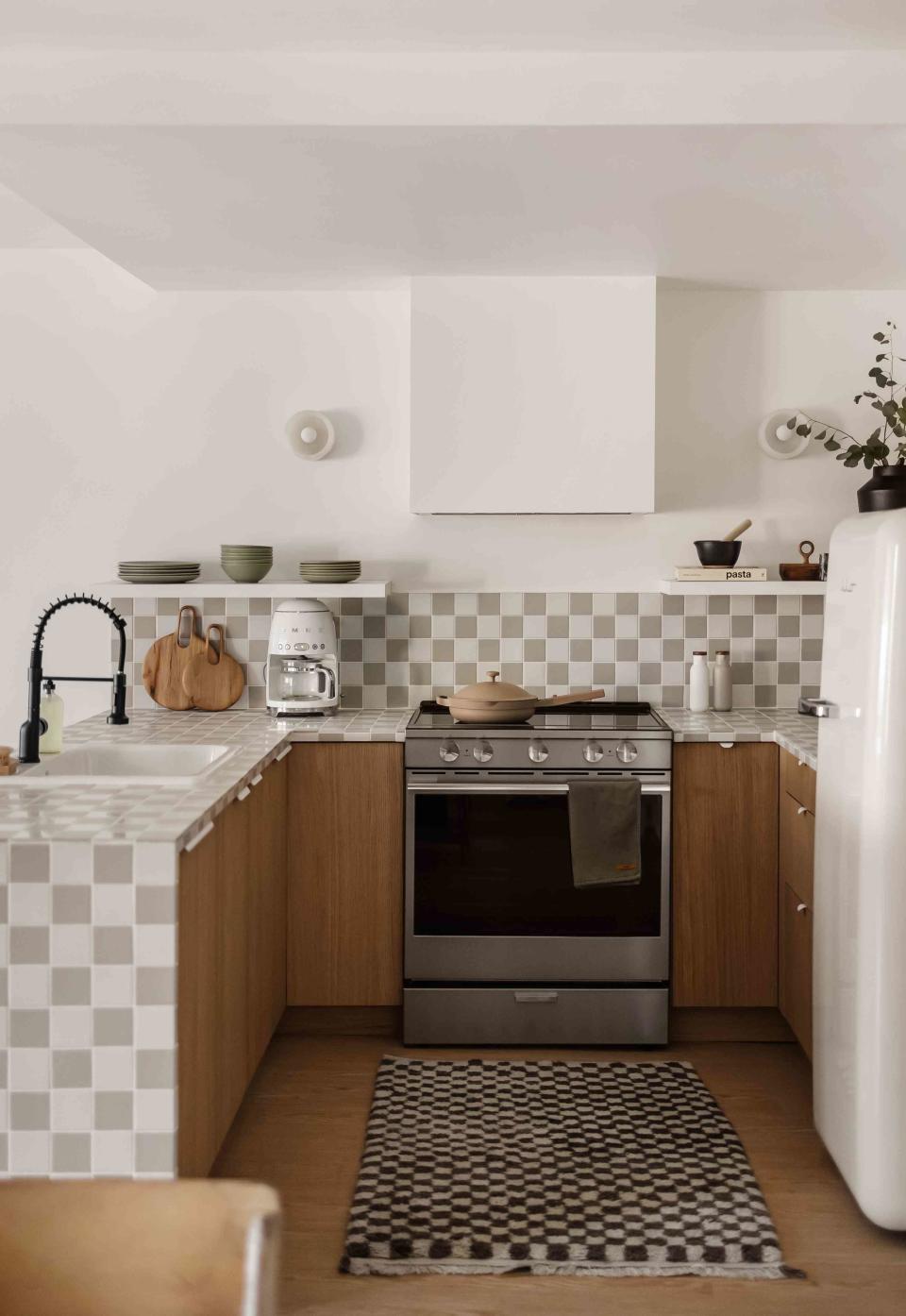Prepare Yourself: Tiled Countertops Are Making a Comeback
This trend revival is form and function at its finest.

Michelle Johnson; Project: The Lake Placid Lodge by You Should Stay Here; Interior Design: Twenty-Two Twelve and Autumn Hachey
Tiled countertops are making a comeback and, before you conjure images of a dated kitchen with florescent overhead lighting, rest assured this iteration of the trend is taking shape in a decidedly different way than eras past.
Interior designer Jillian Smith-Moher of Twenty-Two Twelve isn’t afraid to let the countertops do the talking in her projects, and one way that she lets them drive the conversation is by utilizing tile. It’s understandable that tile countertops can be a bit intimidating without the right expertise, which is why Smith-Moher has shared all her tips, tricks, and considerations for perfecting tile countertops.
Why Tiled Countertops Are Popular (Once Again)
If we’ve learned anything about design trends in 2023, it’s that what’s old is new again. Nostalgia is driving many trends, and tiled countertops are yet another avenue to deliver the warmth of yesteryear. “People are yearning for cozy and interesting spaces,” says Smith-Moher. “Tiled countertops evoke a feeling that is reminiscent and playful.”
Beyond the feelings they evoke, tiled countertops also have a draw for those looking to add a punch of personality to their space. Tile comes with an opportunity to play with pattern—whether it’s a checkerboard-style installation or tiles with graphic designs—and showcase the homeowner’s unique aesthetic.
History of Tiled Countertops
In order to understand today's resurgence in tiled countertops, it’s important to understand their roots. According to an article by the Preservation Artisan’s Guild, tiled countertops became popular in the early 1900s as a result of increased awareness of germs and cleanliness. Previously, countertops were primarily made of more porous wood surfaces and the actual countertop itself wasn’t the continuous surface that we expect today. Instead, countertops were simply the tops of furniture chests and cabinets.
These furniture surfaces were the first to receive the tile treatment. Due to its proximity to the Sanitary Movement of its day, tiled countertops in the early 1900s also often featured very tight grout lines in order to cut back on lurking bacteria. The style evolved over the years, taking over surfaces that are more in line with modern countertop designs found atop rows of base cabinets. Color, shape, and grout lines all evolved as tile countertops ebbed and flowed in popularity as the years went on, eventually leading to the resurgence we see today.
How to Modernize Tiled Countertops
While tiled countertops started off with a more streamlined approach when they came on the scene more than a century ago, they eventually took a turn that resulted in glossy, thick tiles that read more clunky and less classic. Today, there's a different look taking shape altogether. “Tiled countertops were previously installed with chunky trim pieces, while today they are being installed in a cleaner way that is more modern and minimalistic,” explains Smith-Moher. “There has also been a shift from glossy tiles to a matte finish, which changes the aesthetic.” Today’s take on tile can read more natural and earthy than years past, drawing on yet another home trend that's soaring in popularity right now.
Design Considerations
“As tiled countertops are by no definition formal, they don't work in every application,” says Smith-Moher. “They work well in spaces with a quirky, casual but joyful aesthetic.” The designer says the trick is allowing them to revel in the spotlight, letting other style choices in the space take a more subdued or subtle approach. “Tiling your countertops is a bold choice, so adding too many competing design features would distract from the visual impact,” she says. For Smith-Moher’s Lake Placid Lodge project, pictured above, the designer called on a white and beige checkerboard pattern that she described as “both dramatic and neutral.”
When designing a room with tiled countertops, think soft neutrals, natural elements, and even minimal decor and furnishings. A tiled countertop can be the focal point of a space, acting both as a showpiece of your bath, laundry room, or kitchen, and driving the room's style and aesthetic. When pulled off, tiled countertops marry both form and function in the best way.
Lifestyle Considerations
Porcelain and ceramic tile are the most commonly used tiles for countertops today, which have the benefit of being able to withstand heat and avoid stains. Both of these features make them compelling choices for families, home cooks, or those who need their kitchens to work for them while also providing a style-forward approach.
One drawback to consider is the grout lines, which can make cleaning tricky. Grout is also prone to stains, though Smith-Moher says keeping Barkeeper’s Friend at the ready can help combat any discoloration and buildup.
For more Better Homes & Gardens news, make sure to sign up for our newsletter!
Read the original article on Better Homes & Gardens.

